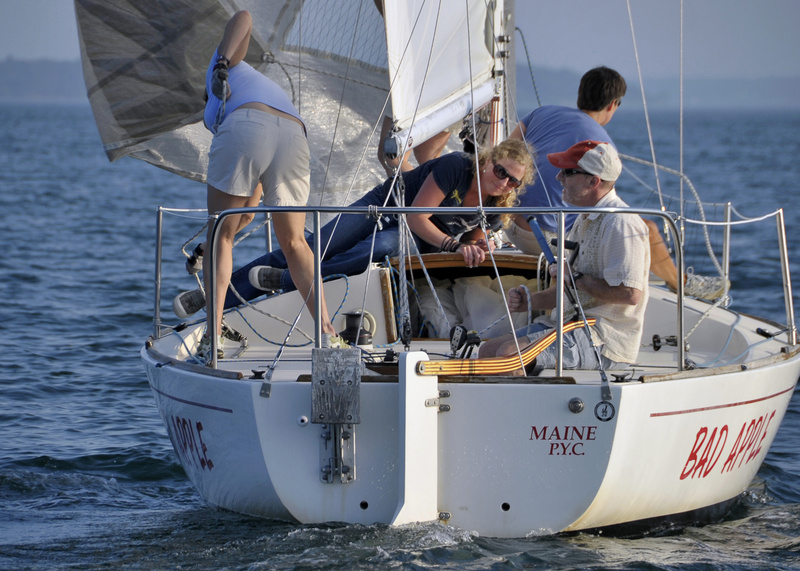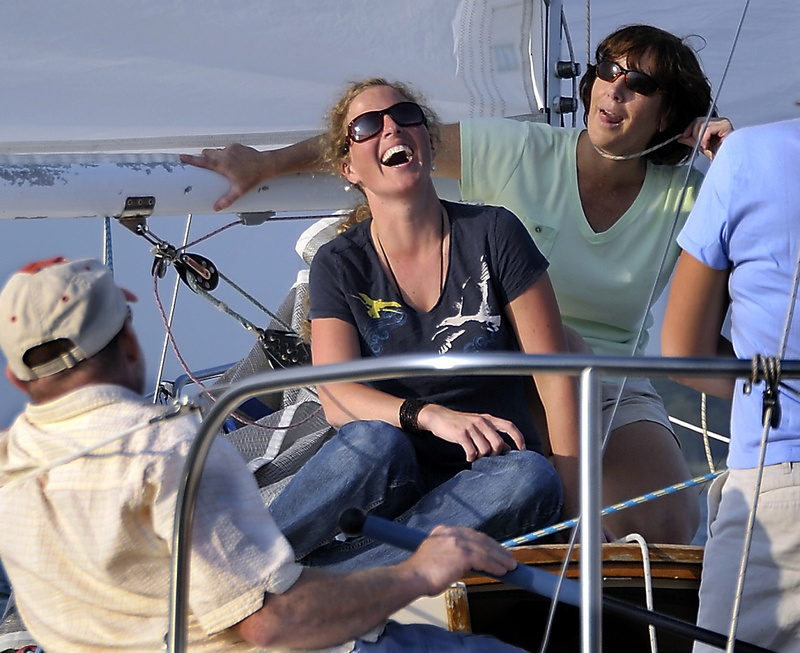Sailboats dot the water off Portland’s coast, looking from a distance like paper creations floating in the bathtub of Casco Bay.
They inspire a romantic one-with-the-sea feeling, their full sails like the puffed chests of proud soldiers.
But I recently learned that there’s nothing romantic about dodging a swinging boom that seems intent on playing T-ball with your head.
Since my sailing experience has been limited to watching from shore and seeing pirate movies, and I thought starboard was a reference to the nation’s space program, I needed a lesson that started with the most basic of basics.
HOT MAMAS WITH THE TEIA CLUB, PEAKS ISLAND
On Peaks Island, the TEIA Club (that’s the Trefethen-Evergreen Improvement Association) has been helping novice sailors take to the water for years.
Allie Jones, Olivia Weiser and Sarah Esocoss were our youthful instructors for the Monday night Hot Mamas ladies’ sailing lesson. Weiser began with some fundamental terms, including the points of sail, which refer to the sailboat’s position in relation to the wind.
“You always want to pay attention to where the wind is coming from,” she said.
She pointed out the different sail positions — sails in toward the wind, sails out when heading away from it — and we used chairs and props to practice how a skipper (the person steering) has to switch seating in the boat, to always sit on the opposite side from the sail.
All the while, the skipper needs to hold on to the tiller (the handle connected to the steering rudder) and mainsheet (the line controlling the mainsail).
Of course, learning to sail is best done on the water, so out we headed to the dock for some full-on immersion learning aboard small two-person boats called 420s.
Jones, Weiser and Esocoss walked Wendy Almeida and me through the various lines, knots and clips, hoisting the mainsail and the jib (the smaller sail fixed to the boat’s bow).
After sliding the boat into the water, Almeida and I climbed in as the instructors pointed out the essentials: The tiller controls the rudder, which steers the boat. The mainsheet is a line that controls the mainsail. The skipper handles both of those. The crew, sitting forward in the boat, is responsible for holding the jibsheet, the line controlling the jib, and shifting position to counterbalance the boat’s heeling, or tipping.
Five minutes in and I was already having trouble keeping things straight.
We cruised through Casco Bay, dodging boats and buoys. I kept the sail in as instructed, adjusting the tiller to keep the boat straight. When it was time to tack, or turn the boat while sailing into the wind, I moved the tiller to start the turn, then changed position from one side of the boat to the other, making sure to duck under the boom swinging over the boat and making sure not to let go of the mainsheet or the tiller.
We practiced putting the boat into “safety position,” with the bow headed directly into the wind and the sails loose and flapping. This “in irons” position, Jones said, is good for slowing things down if someone — ahem — is freaking out and needs to take the speed down a notch. It was also a good time for the skipper and crew to swap places, as Almeida and I did a few times.
After a couple of hours pacing the bay, we were able to call the lesson a success: It was all starting to make sense and no one went overboard.
WEDNESDAY-NIGHT REGATTA AT PORTLAND YACHT CLUB, FALMOUTH
With my sailing confidence buoyed by a successful first attempt, I headed over to Portland Yacht Club in Falmouth a few days later. The Wednesday night regattas there run all summer, and boats needing crew are often willing to welcome a novice aboard.
I joined the crew of the Bad Apple, a J-24 owned and captained by Bruce Morse, which was notably larger than the 420 of my sailing past. I was comforted to see some features I recognized, like the tiller, the rudder and the boom (all of which I pointed to and named out loud in an effort to show I wasn’t completely lost). I also remembered that “port” referred to the left side of the boat and “starboard” to the right. If all else failed, I could at least throw some vocabulary around.
The crew, including Shelly Paules, Brooks Neal and Meg Fenderson, worked to raise the sails and ready the boat, seemingly unaffected by the methodical rise and fall of the deck. I worked to stay upright.
Eventually my legs adapted (I also took the liberty of leaning on things) and I assisted Paules with the mainsail, sliding the bottom into a slit in the boom.
My purpose on the Bad Apple sounded simple: hang out on one side until told to move to the other, aiming not to get knocked overboard or unconscious by the swinging boom in the process. Having already outwitted the boom in the 420, I felt adequately trained.
We made our way out into the bay to join the dozen or so other J-24s jockeying for place near the race starting line. Unlike auto, cycling or horse races, where anxious contenders line up shoulder to shoulder at the start, sailboats are compelled to keep moving. It looks chaotic, with boats passing briskly in opposite directions like a crowd of pedestrians in Times Square. Fenderson called out the countdown, “One minute, forty-five, fifteen, go,” and the boats were off.
Paules kept an eye on the boats nearby, calling out their proximity.
Morse maneuvered the Bad Apple upwind or down in an effort to find a windy sweet spot, and there were several near-collisions during which I gasped and pointed, although none of the other sailors appeared the least bit worried.
When we needed to tack, Morse called out, “coming about.” That was my signal to hit the deck as the boom swung overhead, then scramble over to the other side on my stomach like a soldier in a boot camp obstacle course.
Approaching the first marker, Paules and Neal instructed me to hang low under the boom in the center of the boat. It was going to be a flurry of rear ends and elbows once we rounded the corner, they said.
Coming out of the turn, Paules scrabbled to lower the jib as Neal rushed to pull the spinnaker from a hanging bag below deck, like pulling a large bedsheet out of the dryer.
I watched from my crouched position as the spinnaker was raised and filled with wind. Our puffed spinnaker was stark white, not brightly colored like some, and it looked noble leading the Bad Apple charge downwind.
Between tacks and jibes (turning the boat when sailing before the wind), the crew took our places on the boat’s side, our feet dangling over the water.
With the mellow wind pulling us along and the late-summer sun keeping the air warm on the water, this was the kind of sailing romance is born out of. But while we looked like casual tourists on an Old Port trolley ride, our presence there wasn’t accidental. Just as body weight was central in counterbalancing the winded pull of the mainsail on those small 420s, our weight helped balance the J-24, too.
We placed third in the first race, then headed out for a second go. But only minutes in, after we rounded the first marker, the wind disappeared.
The water quieted its agitation. And suddenly those dozen boats went from “sailing vessels” to “very expensive buoys.”
After a while, when it became clear that the fickle wind wasn’t deigning to rouse itself, three shots sounded over the water to signal that the race had been called. Motors were pulled from below decks and started with echoing coughs. One after the other we made our buzzing way back toward the club.
Maybe my minimal sailing vocabulary didn’t impress anyone at Portland Yacht Club. But what was appreciated, my fellow crew for the day said, was the effort.
“Some people come on just wanting a sailboat ride,” Morse said. Those folks might be better off buying a ticket on a local schooner. But novice sailors who really want to learn are welcome — so long as they know how to duck.
Staff Writer Shannon Bryan can be contacted at 791-6333 or at:
sbryan@mainetoday.com
Send questions/comments to the editors.




Success. Please wait for the page to reload. If the page does not reload within 5 seconds, please refresh the page.
Enter your email and password to access comments.
Hi, to comment on stories you must . This profile is in addition to your subscription and website login.
Already have a commenting profile? .
Invalid username/password.
Please check your email to confirm and complete your registration.
Only subscribers are eligible to post comments. Please subscribe or login first for digital access. Here’s why.
Use the form below to reset your password. When you've submitted your account email, we will send an email with a reset code.